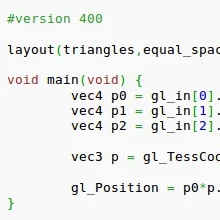OpenGL 4.3, OpenGL ES 3.0 Specifications Unveiled

It's been twenty years since the release of the original OpenGL specification and this royalty-free multi-platform graphics specification keeps moving forward. New functionality provided by the OpenGL 4.3 specification includes: compute shaders leveraging GPU parallelism within the context of the graphics pipeline, shader storage buffer objects, texture parameter queries, high-quality ETC2/EAC texture compression as a standard feature, debug capabilities to receive debugging messages during application development, texture views for interpreting textures in different ways without data replication, increased memory security, and a multi-application robustness extension.
In traditional NVIDIA fashion, they already have beta OpenGL 4.3 proprietary drivers (Linux support included) at NVIDIA.com. AMD will likely put out a new beta of their AMD Catalyst Linux/Windows drivers soon to enable preliminary OpenGL 4.3 / GLSL 4.30 support soon. For the open-source Mesa/Gallium3D support, we're realistically not looking at that support to arrive until 2014 or later unless there's some significant investments made. Right now we're not even looking at OpenGL 3.1 until early 2013.
For mobile and other scenarios, OpenGL ES 3.0 was also released as the first update to OpenGL for Embedded Systems since 2007. OpenGL ES 3.0 is backwards compatible with OpenGL ES 2.0 while drawing on features from OpenGL 3.3 and OpenGL 4.2.
Among the OpenGL ES 3.0 features are enhancements to the rendering pipeline (occlusion queries, transform feedback, instanced rendering), ETC2/EAC texture compression, a new version of the GLSL ES shading language, and enhanced texturing functionality.
It will be easier/quicker for Mesa to support OpenGL ES 3.0 than OpenGL 4.3 since the embedded-focus specification builds upon OpenGL 3.3 / OpenGL 4.2, but there's still more work to be done within Mesa's GLES support until it will be in compliance with GLES 3.0.
The press releases with additional details on OpenGL 4.3 and OpenGL ES 3.0 are available from Khronos.org.
In addition to the updated desktop and mobile/embedded graphics APIs, Khronos also released a new graphics texture compression scheme that is royalty-free and will hopefully begin to unseat S3TC.
46 Comments

